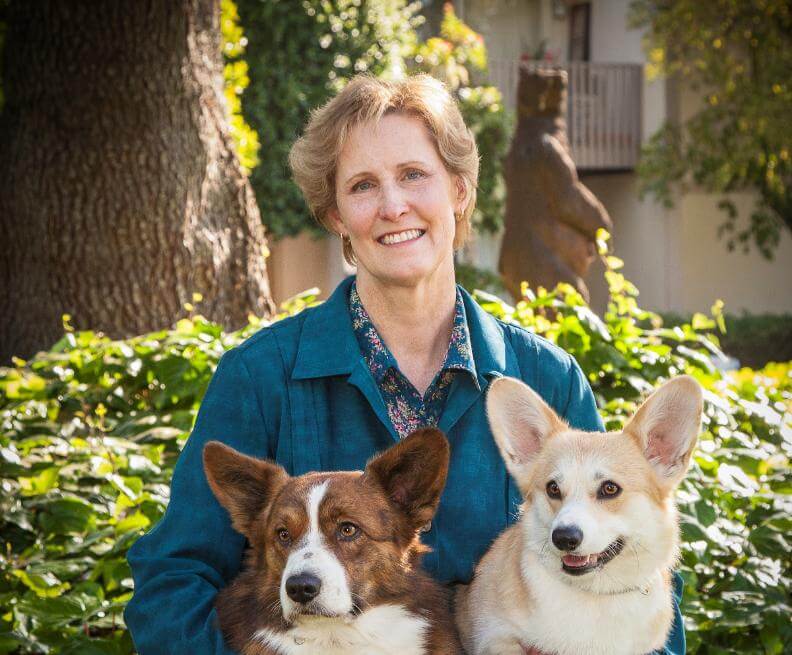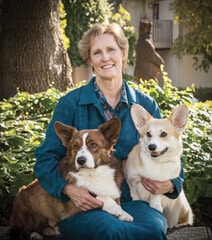Interview with Herding Group Judge Marilyn Van Vleit
I have been breeding Pembroke Welsh Corgis for over forty years and have produced many champions and performance winners. My dogs have won honors at National Specialties as well as at multiple regional specialties. My emphasis in breeding has always been to produce Pembrokes that are sound in mind and body. Although Pembrokes are my first love, I’ve also enjoyed breeding quality Cardigan Welsh Corgis for the past 16 years.
My activities to support my breed include membership in several regional clubs, including the Columbia River Pembroke Welsh Corgi Club of which I’m a charter member and current President. I’m also the Treasurer of Oregon Dog Judges. In the past years, I’ve served the Pembroke Welsh Corgi Club of America (PWCCA) in many ways, including as President, Secretary, Board Member, and chairing several committees. I currently serve as the PWCCA Judges Education Chair.
I am approved to judge the Herding Group and some of the Hound Breeds. I’ve had the privilege of judging Corgis in eight countries. One of the highlights of my judging career was judging the Pembroke National.
Where do I live? How many years in dogs? How many years as a judge?
Marilyn Van Vleit: I was born and raised on a small island in Southeastern Alaska. My involvement in the sport of purebred dogs began there, then expanded when I moved to the big city of Anchorage. The shows there were small, few, and far between.
What is my original breed? What is/was my kennel name?
Marilyn Van Vleit: My first breed was the German Shepherd Dog. At that time, competition was fierce, and I learned to train and handle my own dogs, and then for others. I found it very exhilarating to be on the end of the lead of a beautifully gaiting GSD! Then, 45 years ago, I obtained my first Pembroke Welsh Corgi. Although I have now lived in Salem, Oregon, for 35 years, my kennel prefix “Aurora” recognizes my Alaskan heritage. It also means “new dawn,” which is very fitting.
I began judging Pembrokes over 15 years ago and have had the honor of judging them in eight countries. Through the encouragement of other judges, I later began applying for more breeds, and I am now approved for the Herding Group, plus a portion of the Hound Group.
Can I list a few of the notable dogs I’ve bred? Any performance or parent club titles?
Marilyn Van Vleit: Along the way, I had excellent mentors, and with their assistance, I bred many conformation and performance winning Corgis. One of my fondest memories is being awarded Best in Show with an 11-month-old bitch from the Bred-By Exhibitor Class. Several of my dogs have done well in both Sweepstakes and at the Breed level at the Pembroke National Specialty. A highlight was winning WB from the 6-9 Month Class! American/English Champion Aurora Archery Summit was a specialty winner in both the US and in England. To my knowledge, he was the only American dog to win at the English League Show. In addition to Pembroke Welsh Corgis, I’ve also bred Cardigan Welsh Corgis in recent years. Additionally, I had the good fortune of judging specialties in both New Zealand and Australia early in my judging career. There I made contacts that allowed me to import several excellent dogs and also to breed to imported frozen semen from those countries. One of those imported dogs, NZ & Am. Ch. Badagri Breakdance, has made a significant contribution as a stud dog, siring several #1 ranked Cardigans.
What are the qualities I most admire in the Herding breeds?
Marilyn Van Vleit: In the Herding Group, form definitely follows function. Most of these dogs have duties that require a fit body, a sound mind, and structure that allows them to work for long hours. Dogs with short strides, steep shoulders, poor feet, imbalance, and soft toplines would fail on the job. Keeping the breed’s purpose in mind while judging always aids in making the initial sort. Of course, understanding breed type is critical toward preserving the ultimate quality of any breed. Most of these breeds are not “push button” show dogs. They are thinking, alert, and active. They react to stimulus and are often a bit too eager. This is part of the pleasure in judging them. A dog that exudes breed type, and then moves easily around the ring, is a delight.
Have I judged any Herding Group Specialties?
Marilyn Van Vleit: My judging experience has included a Herding Group specialty, in addition to many breed-specific specialties. Each one of these experiences has afforded me a better and deeper understanding of the breed. Because a specialty draws larger entries, it allows a judge to really focus on the finer points and compare a greater number of dogs to the standard. Often, a larger entry also points out some prevalent problems the breed is dealing with.
Do I find that size, proportion, and substance are correct in most Herding breeds?
Marilyn Van Vleit: Overall, I do think the size, proportion, and substance are correct in most Herding breeds. Early on, the Miniature American Shepherd seemed to struggle to find the right amount of substance, soundness, and size. Lately, I’ve been pleased to note they are much more consistent and the quality is much deeper. Recently, I was pleased to award a Group One to a lovely example of the breed.
Is breed-specific presentation important to me as a judge? Can I offer some examples?
Marilyn Van Vleit: A breed-specific presentation is as important as a breed-specific judge’s exam! Understanding the correct speed for a breed, how much lead to allow, and how high or low to bait them can make all the difference. Presenting a Pembroke is considerably different than presenting an Old English or a German Shepherd.
What about breed-specific movement? Do I demand this from Herding Dogs?
Marilyn Van Vleit: One of the most common mistakes is moving a dog too fast. It may feel flashy to the handler, but it often just destroys how the dog looks and moves. Another pet peeve that I have is an incorrectly groomed or trimmed dog. Having a Pembroke trimmed up around the tail, like an Aussie, ruins the profile. It no longer becomes an enhancement, and it makes a perfectly good Pembroke look out of balance and shorter-bodied. Many of the Herding breeds specifically state in their standard (and provide instructions to judges) that the dog should be shown in a natural state, without excessive grooming or trimming. A quality dog is easy to see, without all the special attention to coat. Feeling product in the coat is also distasteful. Sometimes I’ve had to use handi-wipes to remove the stickiness from my fingers before examining the next dog.
Are the Herding breeds in good shape overall? Any concerns?
Marilyn Van Vleit: It is a pleasure to judge the Herding Group and the breeds represented. Overall, the breeds are in good shape.
In my opinion, how do today’s exhibits compare with the Herding Dogs of the past?
Marilyn Van Vleit: In many cases, I think they are far better than they were in the past. Breeders and exhibitors have less tolerance for poor temperament. I see better type in most of the breeds than in the past. However, the struggle continues with combining soundness with an easy side gait.
Why do I think Herding Dogs can often become outstanding Show Dogs?
Marilyn Van Vleit: An outstanding show dog is one with a handsome outlook, good use of its body when moving, and has showmanship. The dog that says, “Look at me!” simply demands the judge’s attention. Herding dogs can make outstanding show dogs. They are bred to work in conjunction with a human to accomplish a task. This makes them attentive, trainable, and eager to please. They look at their handler and watch for signals. It is not just the bait that keeps them on their toes. When it comes down to the last decision between two good dogs, the one that edges out is the showman.
I think every judge has some favorites breeds they like to judge. When I open up the judging program and see that I have a big entry in some of those favorites, I feel like a kid in a candy store! Because I enjoy judging, I try to make the time that I spend with each exhibit worthwhile. The best compliment is when an exhibitor (who didn’t win) thanks you for judging their dog that day.
Judging the Herding Group is the icing on the cake for a judging day. The dogs gait into the ring with excitement and enthusiasm. As they make their sweep around the ring, I smile, and so does my heart.
Just for laughs, do I have a funny story that I can share about my experiences judging the Herding Group?
Marilyn Van Vleit: Even the most seasoned exhibitor can be nervous in the ring. I feel part of our job as judges is to put them at ease and make it a pleasant experience. However, I also feel it is the exhibitor’s responsibility to be ready to enter the ring promptly and to have watched the judging pattern prior to entering. It is also the exhibitor’s responsibility to prepare their dog for the ring.
I remember trying to see the sides of a dog’s mouth to complete the exam. Before we were through, the dog was rolling around on the floor with the exhibitor wrestling with the mouth. I was doing my best to be patient and understanding. Finally, the dog yawned, and I got a good look. We both laughed and went on with the individual moving exam.
Judging the Herding Group is the icing on the cake for a judging day. The dogs gait into the ring with excitement and enthusiasm. As they make their sweep around the ring, I smile, and so does my heart.









